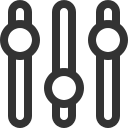Creative Process
Description
In this step, there is a creative process of idea collection, structuring and valuation. It is based on the task definition and the elaborated objectives. First of all, the creative process is prepared by activation of the right hemisphere through a special exercise whereat the participants have to coordinate the movements of their left and right arms and legs by performing tasks with a ball. For the collection of ideas, there are a number of different techniques that can be chosen from. Alternatively all of them can be used. As the foci of the methods vary, it might be practicable to switch between different methods in the different process iterations (see below). In the first iteration one or more basic ideas will be created. In later process iteration the creative process focuses more detailed on storytelling, usability etc. The generated game ideas establish a basis for the selection of game mechanics and dynamics as well as for the storytelling (see next step).
Tools, Methods and Links
We tested a number of creative methods for this process step. Based on our experience, we recommend the following methods, each with a specific focus.
Warming up / Activation of the right hemisphere
Exercise 1
Stand upright and relaxed with your feet shoulderwide. Take a tennis ball in each hand. Now throw the tennis ball in the right hand about 25cm high and catch it. Repeat this for one minute. Then, go on and simultaneously throw the ball in the left hand about 50cm high and catch it again. Do this also for one minute. The task will get even more complex by adding a third tennis ball. Put it under your right foot and make circles with the foot, while you go on with throwing the other balls to a height of 25cm and 50cm.
Exercise 2
Take a small ball (max. diameter: 10cm), such as a tennis ball. Let it circulate around your hips by handing it from the right into the left hand and vice versa. Change the direction after one minute.
Exercise 2
Sit down on a chair at a table. Make circles with your right foot without touching the ground. Simultaneously, write your name in handwriting on a sheet of paper.
6-3-5 method
We recommend the 6-3-5 method when focusing starting points of the game idea. Take 6 people, everyone equipped with one sheet of paper containing three columns. Then, everybody writes down three ideas - one per column. Then, give your sheet to your neighbor, who can get inspired by your ideas and add three new aspects/ideas to yours. You'll do this in five iteration. Thus, in the end, each sheet contains three ideas from every participant. This method is suitable to generate a lot of ideas (90!) in short time.
Genre method
The genre method, which we developed, is very useful for creating a story. Here, any genre (like western, comic etc.) is chosen at random and all participants try to transfer the given situation to this genre. Ideas, which aspects of these genres could solve a problem or make it more fun, what could be an interesting story behind the tasks the users have to perform and even more can be developed with this method.
Headstand technique
For usability and user experience issues, we recommend the headstand technique. Just formulate the question in the opposite direction than originally intended. For example, you can ask: "What can we do, to make the users dislike the task even more?" Usually, it's very easy to find ideas and "solutions" for such questions. The results help you to identify the "adjusting levelers", and thus makes it easier to find solutions for the original problem.
Mind mapping
As one of the most common creative method, we find mind mapping to be an adequate method to structure the ideas.
Thinking hats method
As the techniques normally lead to a large amount of ideas, which should be reduced, they have to be valued. Here, the six thinking hats method is helpful. You need six participants and each of them gets a specific role (represented by a hat) in order to express and discuss advantages, possible shortcomings etc. of each idea.
Gamification Implementation Chart
The Gamification Implementation Chart is a tool covering the Creative Process as well as parts of the Game Conceptualization. We find it to be useful, especially when quick ideas are needed. It is also appropriate for Gameful Design newbies as it guides through the most relevant questions of the design process. We recommend to print out some copies of the blank canvas to be able to work on a couple of approaches in parallel. Using post its, you can rearrange all elements if necessary.
Readings
Buzan, T., Buzan, B. Das Mind-Map-Buch. Die beste Methode zur Steigerung ihres geistigen Potentials. Landsberg a. L.: Moderne Verlagsgesellschaft, 2002.
De Bono, E. Six Thinking Hats. New York: Viking, 1986.
De Bono, E. Serious creativity: die Entwicklung neuer Ideen durch die Kraft lateralen Denkens. Stuttgart: Schäffer-Poeschel Verlag, 1996.
Linsey, J. S., Becker, B. "Effectiveness of Brainwriting Techniques: Comparing Nominal Groups to Real Terms," in Design Creativity 2010. London: Springer London, 2011, p. 166.
Input - Action - Output

Goals
Strategy to reach the goals



